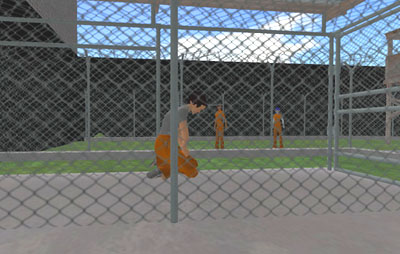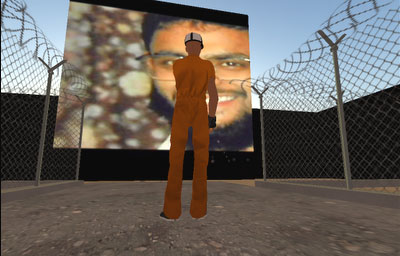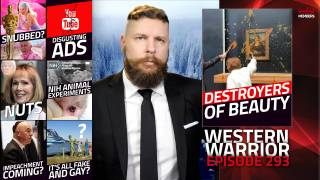Click Here for Torture
Source: vanityfair.com

The author, in digital effigy, kneels in a Guantánamo cell in Second Life. Looking on are the avatars of the virtual model’s creators, Nonny de la Peña (brunette) and Peggy Weil (with blue hair). Courtesy Nonny de la Peña and Peggy Weil.
Two unnaturally sexy activists (at least that’s how they appear online) are trying to raise awareness of the horrors of Guantánamo Bay by inviting visitors to experience it for themselves—inside the virtual world of Second Life. Is this the future of political discourse, or just another game no one wants to play?
It’s customary to begin articles about Second Life with a bit of artful deception, by describing events that take place in the online virtual world as if they were really happening, then to reveal bizarre details that make it clear we’re talking about a computer program.
So here goes.
The last thing I notice before I am hooded is that I’m shackled to the floor of a military cargo plane. I hear it take off. Or land. I can’t tell.
A man shouts, “Shut up!” and I hear a violent blow, but I don’t feel anything. Finally, sunlight seeps through the fabric of my hood. I hear footsteps on gravel. Are they mine? Everything goes black again.
Next thing I know, I’m on my knees on the floor of an outdoor jail cell in Guantánamo Bay. I’m given an orange jumpsuit to put on.
Watching me from behind the chicken wire are two callipygian women who are also in orange jumpsuits. One is a brunette. The other’s hair is fluorescent blue.
“How does it feel?” the brunette asks me. I’m pretty comfortable, I want to say. I had a nice breakfast not too long ago, and now I’m playing on my computer in a well-heated apartment, marveling at how much this character looks like me, and trying to make out your curves beneath your orange onesie. But that’s not what she wants to hear.
The buxom brunette is the avatar, or virtual representation, of Nonny de la Peña, a journalist and filmmaker, whose 2004 documentary, Unconstitutional, focuses on the deterioration of civil liberties since 9/11.
The blue-haired lady is Peggy Weil, an assistant professor in the interactive-media division of the U.S.C. film school. During a residency at the Bay Area Video Coalition, funded in part by the MacArthur Foundation, they designed this simulation of Guantánamo to “raise awareness [that] our government is denying the basic rights of habeas corpus to prisoners,” according to their blog.
The first site (there are four now) was erected on virtual real estate donated by Internet pioneer Joi Ito (featured on Vanity Fair’s 2007 “Next Establishment” list).
The Gone Gitmo project, as de la Peña and Weil call it, has been showcased at several national conferences, including the A.C.L.U.’s Close Guantánamo event on Second Life in January, and at the Sundance Film Festival later that month. Asked what kind of people have volunteered to experience virtual incarceration, Weil says, “We’ve had many Germans.”
The camp I’m in is a model of Camp X-Ray, the temporary detention facility where terror suspects were held and reportedly tortured until it was decommissioned, in 2002.
De la Peña and Weil are adding a version of Camp Delta, as well as a “torture contemplation area.” (“We are not going to torture your avatar,” says de la Peña. “For a lot of reasons. We don’t want to trivialize the notion of torture.”)

Second Life residents can develop an almost umbilical attachment to their avatars. One visitor to Gone Gitmo felt so threatened by seeing her digital doppelgänger detained that she pulled out a virtual baseball bat and started taking swings at de la Peña’s avatar.
I’m ashamed to say I had no such reaction, possibly because this was my first time on Second Life. But, novice that I was, I was nevertheless able to figure out how to crack my cell door open: I clicked on it. Once out, I explored the camp, where various screens played clips from de la Peña’s film Unconstitutional.
I had freely chosen to visit the camp, and there were no guards to stop me from just as freely strolling out the front door or, if I was feeling fabulous, flying away. I could even teleport to a hot tub in Tokyo to chat with avatars who’ve paid real money for their designer genitals. Sex, after all, accounts for an estimated 30 percent of the Second Life economy. This portion of the pie may grow now that the businesses that once drooled over Second Life’s marketing potential have noticed that the number of active residents, which had been steadily rising since 2003, is plateauing at just under 600,000. These people don’t seem to like being preached to.
When I visited one of the first Gone Gitmo sites, I found it eerily deserted, save for a neat brown pile in one of the cells. It was labeled “cat turd.”
De la Peña says the idea behind Gone Gitmo was to create a virtual but accessible version of a place that was real but inaccessible to all but detainees, military personnel, and dedicated lawyers.
One such lawyer, Lieutenant Commander Charlie Swift, who visited the prison regularly for five years, says, “I applaud their efforts. It’s very hard to explain to people what Guantánamo is like.” But, while the model gives a fairly accurate idea of what the prison looks like, a larger truth is lost.
“The irony is it’s the lack of senses that is the real hell, not any particular thing that happens. That is the uniqueness of Guantánamo,” says Swift, who sued George W. Bush and Donald Rumsfeld over the camp’s military-tribunal system, which deprives detainees of many rights afforded prisoners in the U.S. (See “Taking on Guantánamo,” by Marie Brenner.) “You’re strapped down, can
’t see or hear, can’t move, your muscles are cramping, and that’s it.”
If the people behind Gone Gitmo want a truly accurate model, Swift adds, “the rules should change every time.… Psychiatrists will tell you that if the game works perfectly, it’s dangerous for people to play.”
There is another prison on Second Life—one you can’t choose to go to and can’t get out of—a purgatory where Linden Lab, the network’s villainous-sounding creator, occasionally sends cyber-offenders and saboteurs. Its existence was thought to be a rumor until rebellious nerds were relegated there and sent pictures back. It is a moonlit field with infinite rows of corn, where the only entertainment is a tractor you can ride, and a small black-and-white TV playing a moralizing 1940 film called Boy in Court on a loop. Perhaps this geek gulag, said to have been inspired by an episode of The Twilight Zone, could give Second Lifers a truer appreciation for their real-world civil rights.
Video: Youtube.com
Article from: Click Here for Torture






















